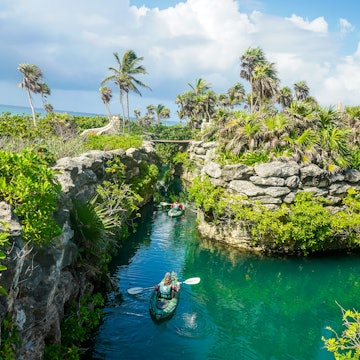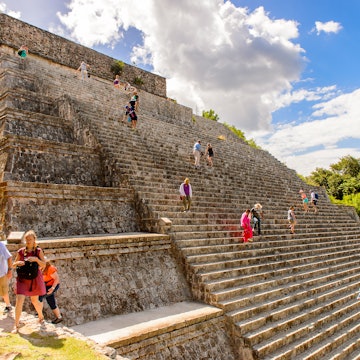
A first-time guide to Chichén Itzá, one of Mexico's most famous Maya sites

May 11, 2025 • 8 min read
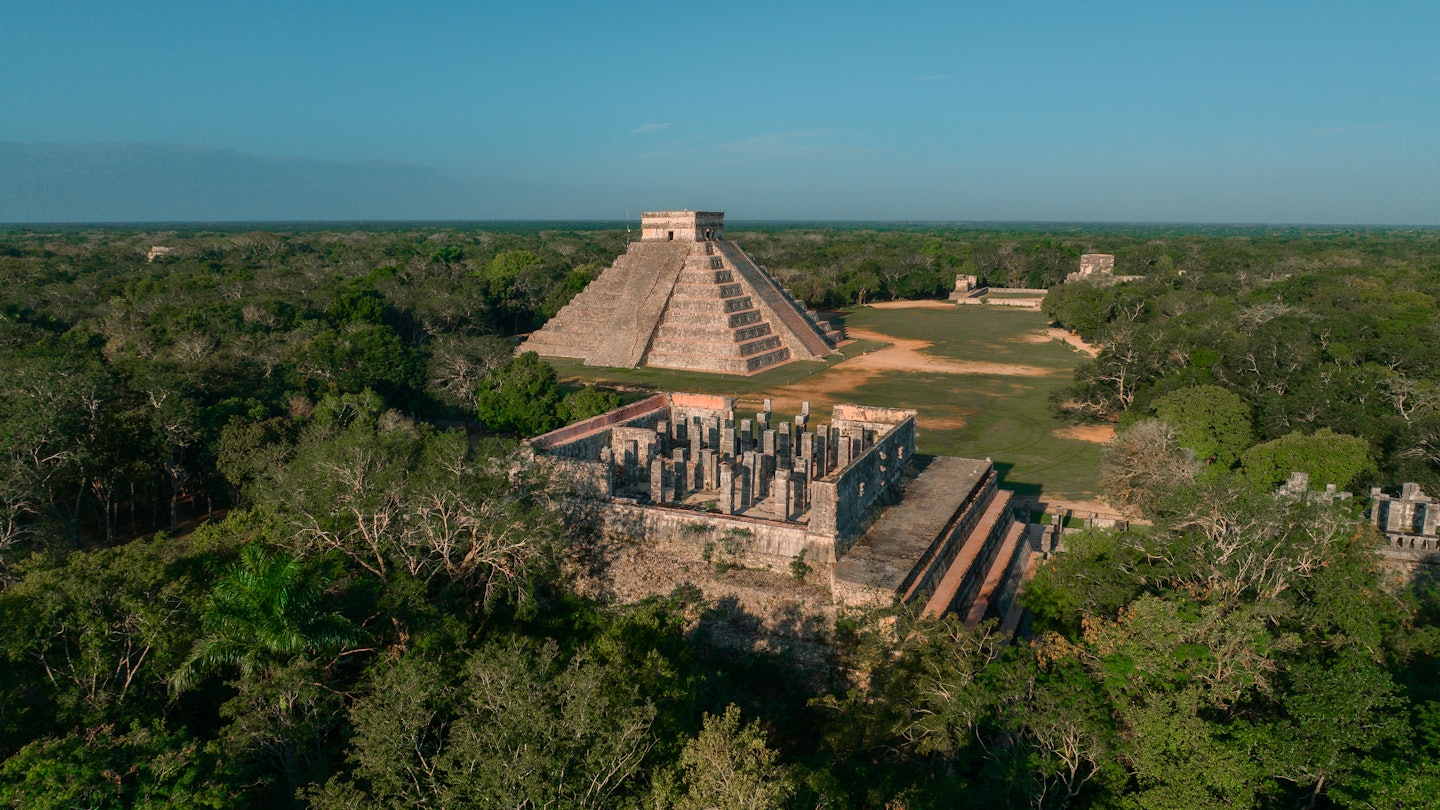
The ancient Maya site of Chichén Itzá in Yucatán, Mexico. Oleh_Slobodeniuk/Getty Images
The most famous and best-restored of the Yucatán Maya sites, Chichén Itzá – while tremendously crowded – will impress even the most jaded visitor. Stretching across 10 sq km (3.9 sq miles), the great city was once home to an estimated 50,000 people during its peak more than 900 years ago. Today, the site has an astonishing array of ruins, including majestic temples and a towering pyramid. Here's everything you need to know about Chichén Itzá and its history to help you get the most out of your visit.
How much does it cost to visit Chichén Itzá?
Admission to the site is M$648 (US$33). This includes access to the ruins as well as the museum, located some 2km (1.2 miles) from the archaeological site. If you’re planning on seeing the sound and light show, you’ll have to pay a separate admission of M$772 (US$39). Drivers will also have to pay for parking (around M$120/US$6.10).

What are the opening hours and when is the best time to visit Chichén Itzá?
The ruins and museum open from 8am to 5pm. Chichén Itzá is always busy, but the crowds (and temperatures) are more bearable in the morning. Arrive at opening time, and you’ll have several hours to explore before most of the tour buses arrive.
How do you get to Chichén Itzá?
First-class ADO buses from Cancún, Tulum, Mérida and other major towns drop you off directly at the entrance to Chichén Itzá. From Valladolid (45km/28 miles east), there are frequent colectivos (shared vans), departing every 20 minutes or so from 2½ blocks west of the main plaza. You can also reach Chichén Itzá by the new rail line Tren Maya. However, be aware that the station is 7km (4.3 miles) from the ruins, so you’ll have to hop in a connecting bus to get to the entrance.
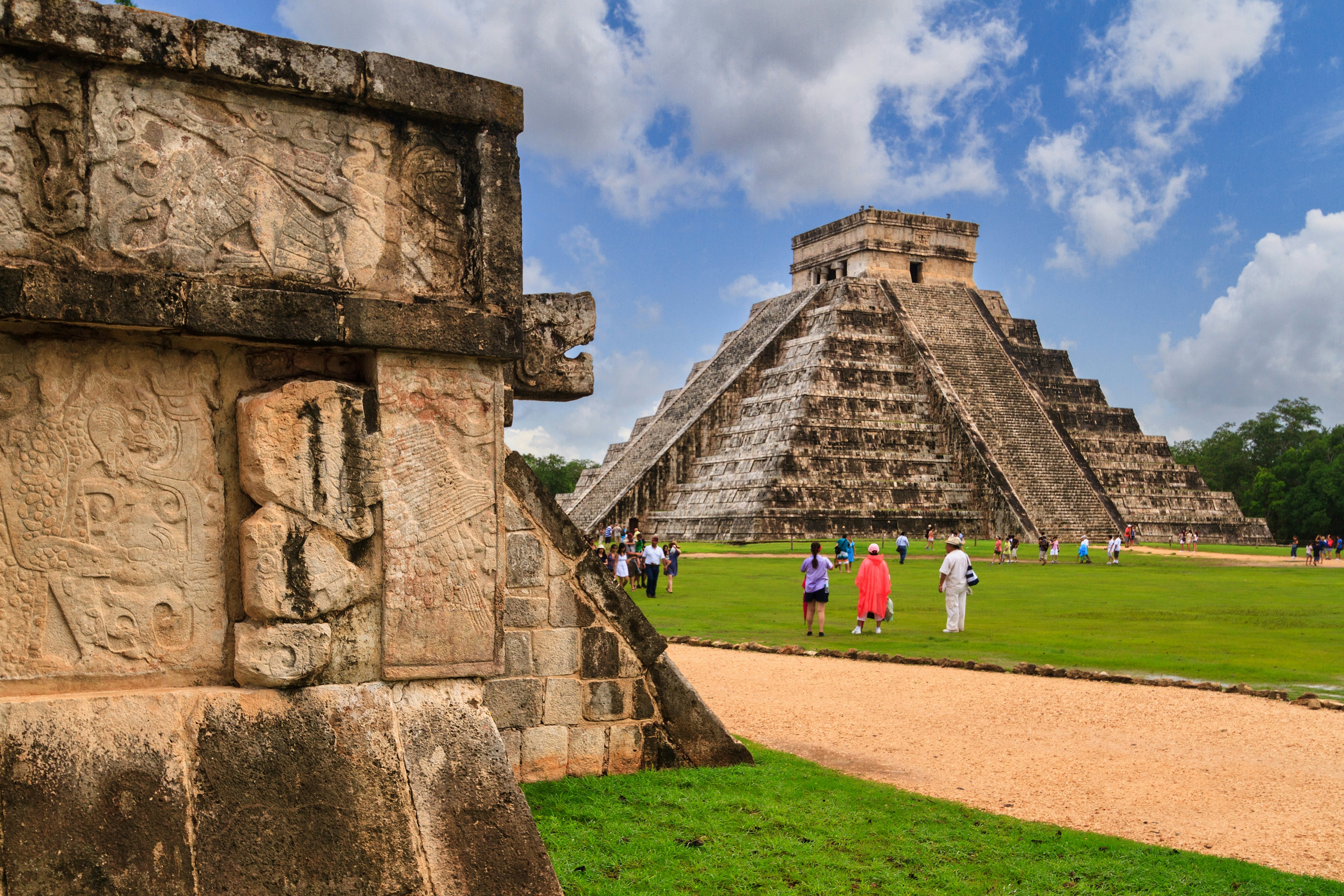
What should I see at Chichén Itzá?
El Castillo (Pyramid of Kukulcán)
Upon entering Chichén Itzá, El Castillo (aka the Pyramid of Kukulcán, which is the Maya name for the plumed serpent god Quetzalcóatl) rises before you in all its grandeur. The first temple here was pre-Toltec, built around 800 CE, but the present 25m-high (82ft) structure, built over the old one, has the plumed serpent sculpted along the stairways and Toltec warriors represented in the doorway carvings at the top of the temple. You won’t see the carvings, however, as ascending the pyramid was prohibited after a fatal accident here in 2006.
The structure is actually a massive Maya calendar formed in stone. Each of El Castillo’s nine levels is divided in two by a staircase, making 18 separate terraces that commemorate the 18 20-day months of the Maya Vague Year. The four stairways have 91 steps each; add the top platform and the total is 365, the number of days in the year. On each facade of the pyramid are 52 flat panels, which are reminders of the 52 years in the Maya calendar round.
The older pyramid inside El Castillo has a red jaguar throne with inlaid eyes and spots of jade; also lying behind the screen is a chacmool (type of pre-Columbian sculpture). The entrance to El Túnel, the passage up to the throne, is at the base of El Castillo’s north side. You can’t go in, though.
Researchers in 2015 learned that the pyramid most likely sits atop a 20m-deep (66ft) cenote, which puts the structure at greater risk of collapsing.
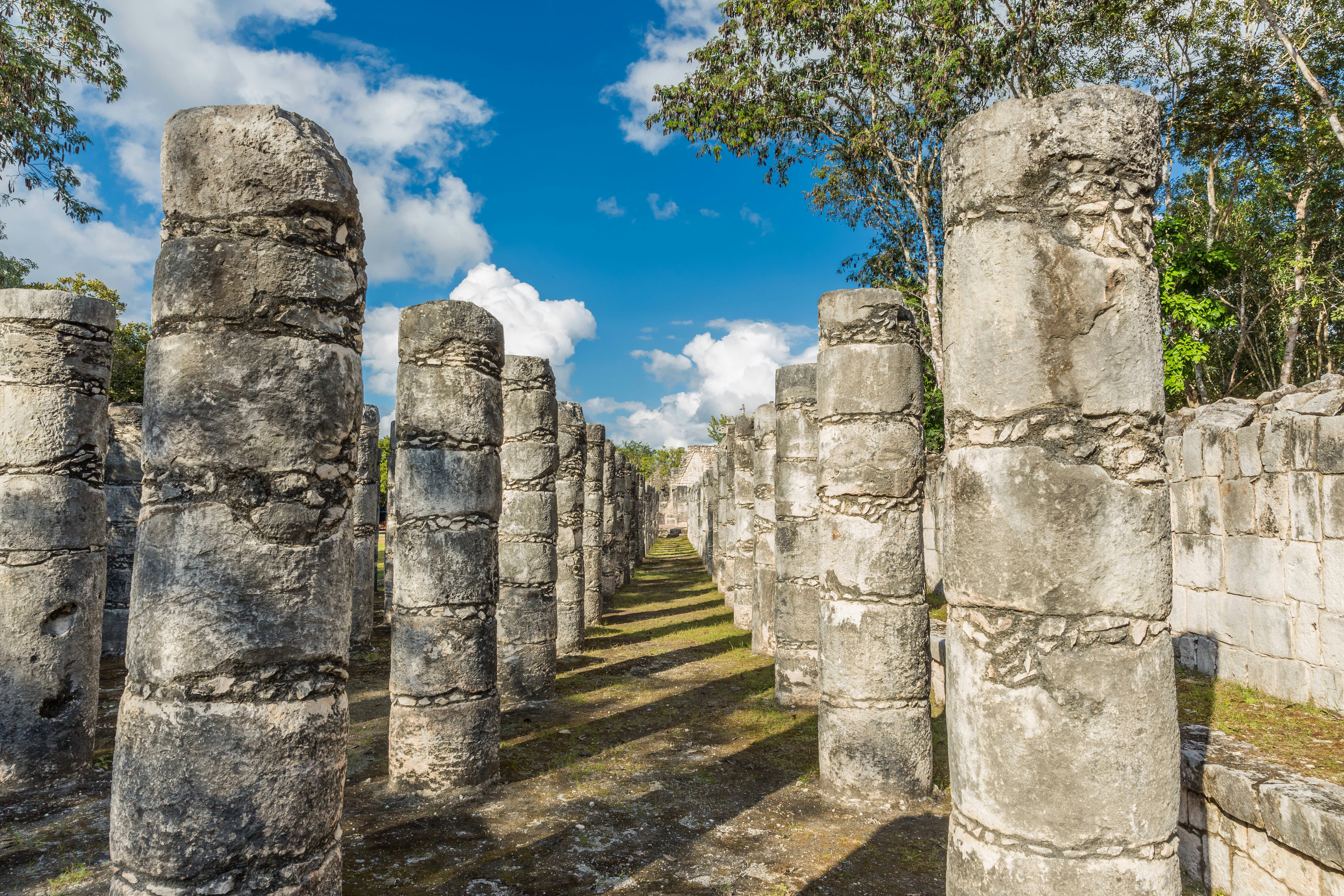
Grupo de las Mil Columnas
This group east of El Castillo pyramid takes its name – which means Group of the Thousand Columns – from the forest of pillars stretching south and east. The star attraction here is the Templo de los Guerreros (Temple of the Warriors), adorned with stucco and stone-carved animal deities. At the top of its steps is a classic reclining chacmool figure, but ascending to it is no longer allowed.
Many of the columns in front of the temple are carved with figures of warriors. Archaeologists working in 1926 discovered the Temple of Chac-Mool lying beneath the Temple of the Warriors.
You can walk through the columns on its south side to reach the Columnata Noreste, notable for the "big-nosed god" masks on its facade. Some have been reassembled on the ground around the statue. Just to the south are the remains of the Baño de Vapor (Steam Bath or Sweat House) with an underground oven and drains for the water. The sweat houses (there are two on site) were regularly used for ritual purification.

Gran Juego de Pelota
The great ball court, the largest and most impressive in Mexico, is only one of the city’s eight courts, indicative of the importance the games held here. The court, to the left of the visitor center, is flanked by temples at either end and is bounded by towering parallel walls with stone rings cemented up high. Along the walls of the ball court are stone reliefs, including scenes of decapitations of players.
There is evidence that the ball game may have changed over the years. Some carvings show players with padding on their elbows and knees, and it is thought that they played a soccer-like game with a hard rubber ball, with the use of hands forbidden. Other carvings show players wielding bats; it appears that if a player hit the ball through one of the stone hoops, his team was declared the winner. It may be that during the Toltec period, the losing captain, and perhaps his teammates as well, was sacrificed.
The court exhibits some interesting acoustics: a conversation at one end can be heard 135m (443m) away at the other, and a clap produces multiple loud echoes.
Cenote Sagrado
From the Platform of Skulls, a 400m (1312ft) rough stone sacbé (a ceremonial path) runs north (a five-minute walk) to the huge sunken well that gave this city its name. The Sacred Cenote is an awesome natural well, some 60m (197ft) in diameter and 35m (115ft) deep. The walls between the summit and the water’s surface are ensnared in tangled vines and other vegetation.

El Caracol
Called El Caracol (the Snail) by the Spaniards for its interior spiral staircase, this observatory, to the south of the Ossuary, is one of the most fascinating and important of all Chichén Itzá’s buildings (but, alas, you can’t enter it). Its circular design resembles some central highlands structures, although, surprisingly, not those of Toltec Tula.
In a fusion of architectural styles and religious imagery, there are Maya Chaac (rain god) masks over four external doors facing the cardinal points. The windows in the observatory’s dome are aligned with the appearance of certain stars at specific dates. From the dome the priests decreed the times for rituals, celebrations, corn-planting and harvests.

Edificio de las Monjas
Thought by archaeologists to have been a palace for Maya royalty, the so-called Edificio de las Monjas (Nunnery), with its myriad rooms, resembled a European convent to the conquistadors, hence their name for the building. The building’s dimensions are imposing: its base is 60m long, 30m wide and 20m high (197ft long, 98 ft wide and 66ft high).
The construction is Maya rather than Toltec, although a Toltec sacrificial stone stands in front. A smaller adjoining building to the east, known as La Iglesia (the Church), is covered almost entirely with carvings.
Gran Museo de Chichén Itzá
Opened in 2024, this spacious beautifully designed museum houses a trove of artifacts unearthed at Chichén Itzá. Sculptures, architectural elements, figurines, pottery, jewelry and other relics are displayed in large exhibition halls that delve into Maya cosmovision, daily life, religion and human sacrifices. Fascinating original pieces date from the site’s earliest foundation (900 BCE) to its heyday over 1000 years later. There’s also a recreation of the interior chamber atop the Pyramid of Kukulkán, with reproductions of the red jaguar throne and a sculpture of the reclining god Chac Mool. The museum is about 2.5km (1.5 miles) from the main entrance to the ruins of Chichén Itzá and is best reached by private car or taxi.

Sound and light show
For a different take on Chichén Itzá, plan an evening visit during Noches de Kukulán, an impressive, but pricey sound and light show that runs Wednesday through Sunday nights. The 25-minute event, in Spanish only, features projections on El Castillo, and you can also take a 45-minute self-guided tour around other dramatically lit parts of the ruins before the show.
Magic of the Equinox
At the vernal and autumnal equinoxes (around March 20 and September 22), the morning and afternoon sun produces a light-and-shadow illusion of the serpent ascending or descending the side of El Castillo’s staircase. The illusion is almost as good in the week preceding and following each equinox (and draws much smaller crowds).

History of Chichén Itzá
Most archaeologists agree that the first major settlement at Chichén Itzá, during the late Classic period, was pure Maya. In about the 9th century CE, the city was largely abandoned for reasons unknown.
It was resettled around the late-10th century, and shortly thereafter it is believed to have been invaded by the Toltec, who had migrated from their central highlands capital of Tula, north of Mexico City. The bellicose Toltec culture was fused with that of the Maya, incorporating the cult of Quetzalcóatl (Kukulcán, in Maya). You will see images of both Chaac, the Maya rain god, and Quetzalcóatl, the plumed serpent, throughout the city.
The substantial fusion of highland central Mexican and Puuc architectural styles makes Chichén unique among the Yucatán Peninsula’s ruins. The fabulous El Castillo and the Plataforma de Venus are outstanding architectural works built during the height of Toltec cultural input.
The sanguinary Toltec contributed more than their architectural skills to the Maya: they elevated human sacrifice to a near obsession, and there are numerous carvings of the bloody ritual in Chichén demonstrating this.
After a Maya leader moved his political capital to Mayapán while keeping Chichén as his religious capital, Chichén Itzá fell into decline. Why it was subsequently abandoned in the 14th century is a mystery, but the once-great city remained the site of Maya pilgrimages for many years.















